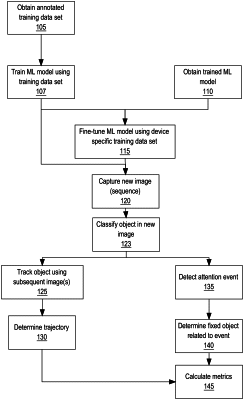| CPC G06N 3/08 (2013.01) [G06F 18/214 (2023.01); G06N 20/00 (2019.01); G06V 10/764 (2022.01); G06V 10/82 (2022.01); G06V 20/41 (2022.01); G06V 20/52 (2022.01); G06V 20/44 (2022.01)] | 18 Claims |

|
1. A computer-implemented method comprising:
capturing a first image of a particular area by an image capturing device, the image capturing device capturing a sequence of images that includes the first image and a second image of the same particular area, wherein the particular area includes a plurality of fixed objects;
determining that a first event of a particular event type associated with a first object of a particular object type occurred by providing the first image as input data to one or more ML models, the one or more ML models trained to identify objects of the particular object type and events, of the particular event type, associated with the objects;
determining image coordinate information of the first event identified within the first image;
based at least on mapping data of the particular area to the image coordinate information, determining a particular fixed object, of the plurality of fixed objects of the particular area, with which the first event is associated;
determining that a second event associated with a second object occurred by providing the second image, of the sequence of images, as input data to the one or more ML models;
determining that the second object is the same as the first object by providing the first image and the second image as input to another ML model, wherein the other ML model is trained to detect whether objects in multiple images are the same;
based at least in part on determining that the second object is same as the first object, determining that the second event is same as the first event;
excluding the second event from calculating one or more metrics for the particular event type;
calculating the one or more metrics for the particular event type for the plurality of fixed objects.
|